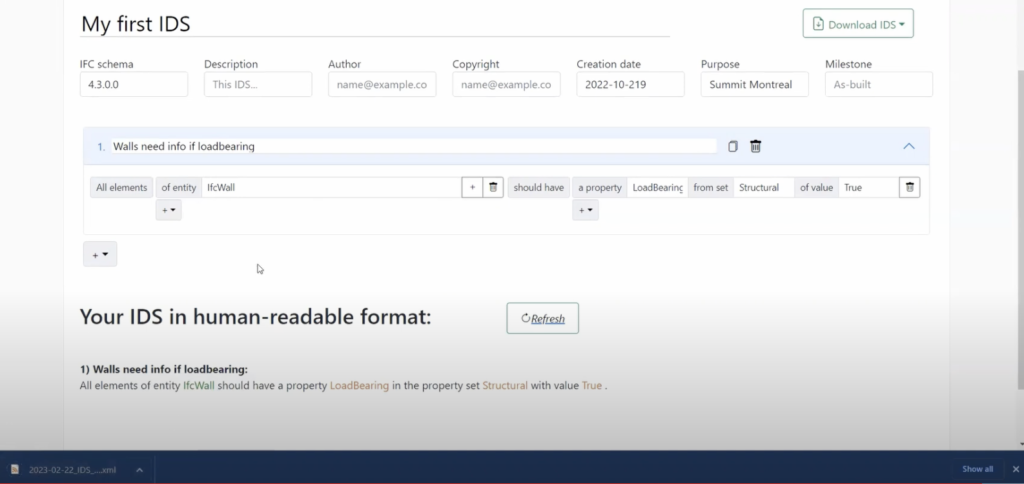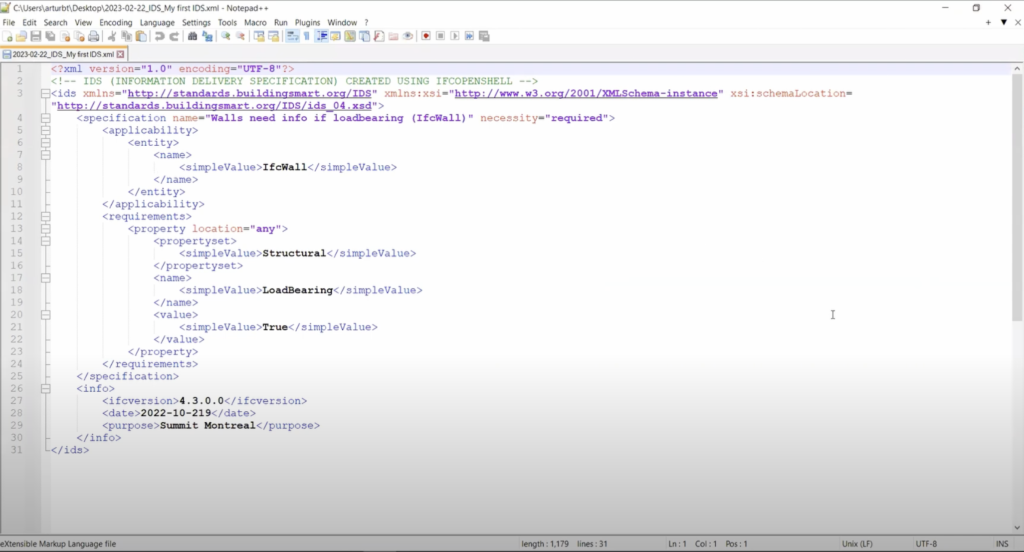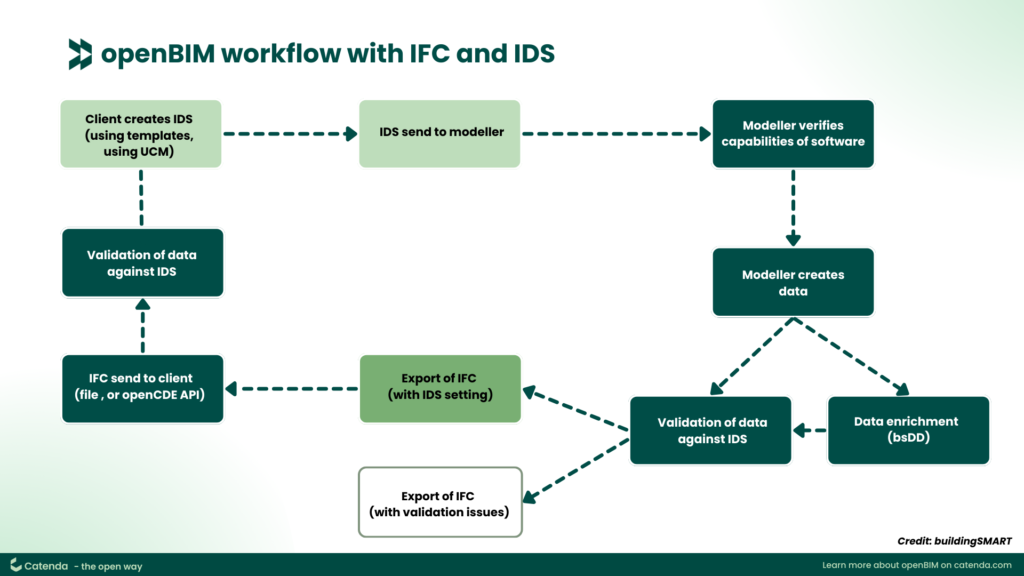In the dynamic world of construction and Building Information Modeling (BIM), the Information Delivery Specification (IDS) emerges as an essential document, serving as the foundation for flawless communication and collaboration in a project.
Let’s delve into what an IDS is and how it supports BIM projects!
What is an Information Delivery Specification (IDS) in buildingSMART standard?
An Information Delivery Specification (IDS) is a crucial computer-readable document that defines and reviews project requirements and can be exchanged with other projects.
It was invented by buildingSMART International and defines how different elements of a project should be built and exchanged. It can be imagined as a list of requirements that a project should meet. These can include aspects such as objects, classifications, properties, materials, and values. They are outlined in a way that facilitates their delivery and exchange, often based on Industry Foundation Classes (IFC) and additional classifications.
What makes the IDS crucial is that the list can be exported as an .xml file. The IDS then is transformed into a .xml standard code that can be imported into other projects.
Accordingly, in case several projects shall meet the same requirements, the IDS can easily be uploaded and the computer will check whether the requirements for the project are being met.
This standard in the Building Information Modeling (BIM) process aids in ensuring service quality and effective project controls, making it an essential part of any construction project.
Here you can find a practical example of an IDS. It can also be used as an Information Delivery specification template:


Role of IDS in Building Information Modeling (BIM)
In the context of Building Information Modeling (BIM), IDS plays an instrumental role in facilitating effective information exchange, minimizing errors, and optimizing workflows.
- It provides a structured and standardized approach to define what information should be delivered, how and when, thereby ensuring everyone involved in a project is on the same page.
- IDS facilitates the integration of various building systems such as interior, envelope, structure, and mechanical, electrical and plumbing (MEP) systems. This is crucial in delivering the required performance of a sustainable building.
- IDS in BIM also fosters interoperability and efficient collaboration throughout the lifecycle of a building – from feasibility and conceptual design through to demolition and recycling stages. This is achieved by its machine-readable nature, allowing different software tools to read, understand and work with the data seamlessly.
Overall, IDS in BIM acts as a bridge between different stakeholders, software tools, and processes involved in a construction project.
Practical Examples of IDS Usage in BIM
In the practical application of IDS in BIM, one can consider its use in information requirements specification.
For example, IDS helps in defining the Levels of Information Need (LOIN) in an employer’s information requirements (EIR) and BIM execution plans (BEP). This helps stakeholders to understand and meet the exact information needs of a project.
Another example can be seen in quality validation with tools like usBIM.IDS. The IDS validator checks the quality of IFC files, ensuring that they comply with the defined IDS.
Furthermore, IDS is instrumental in managing information exchanges in the openBIM IFC process. It ensures that the IFC model files are delivered as per the client’s specifications.
Lastly, IDS usage in the creation of a BIM delivery protocol ensures that the correct information accompanies digital exchanges at all stages of a project’s lifecycle. This enhances the efficiency of design, construction, and operation processes.
IDS in the buildingSMART framework
As the IDS was invented by buildingSMART, it is part of a larger ecosystem of standards and tools developed by the international organization. These include the Information Delivery Manual (IDM) and the buildingSMART Data Dictionary (bSDD), among others.
Together, these resources form a comprehensive framework for managing information delivery in the built asset industry.
What is the relation between IDS and IFC file?
The Information Delivery Specification (IDS) and Industry Foundation Classes (IFC) are interconnected, each playing a vital role in the Building Information Modeling (BIM) process.
While we already got to know what IDS is, IFC is a standardized, open digital description of the built environment. It provides a common language for different software tools, enabling them to communicate effectively.
The connection lies in the possibility for IDS to enhance its Exchange Requirement with helpful information that is already linked to the IFC model.
In a practical example, the IDS assists the modeler or designer in automatically generating the information structure from the order specifications. This information structure is already connected to the IFC model.
This synergy between IDS and IFC ensures a smooth, efficient, and effective exchange of information in the BIM process.

Relation to buildingSMART Data Dictionary (bSDD)
The buildingSMART Data Dictionary (bSDD) and Information Delivery Specification (IDS) are two related but distinct aspects of the buildingSMART standards. The bSDD is an online service hosting terms, properties, units, translations, and relations. It provides a standardised workflow to ensure data quality, information consistency and interoperability.
The bSDD and IDS work in tandem to promote efficient and effective information exchange in the industry.
In practical terms, the bSDD may be used to provide the necessary classifications, properties and allowed values that the IDS would then structure for exchange in a BIM environment.
This combination of the bSDD’s rich library and the IDS’s structured delivery methods ensures seamless data transfer, enhancing collaborative efficiency throughout the lifecycle of a building project.
Future Developments in IDS by buildingSMART
buildingSMART is continuously advancing the IDS standard to meet the evolving demands of the built asset industry. Future developments are expected to focus on:
- Integration with openBIM and openGIS: The IDS development is being expanded to incorporate openBIM at an urban scale, enhancing its interoperability with openGIS. This groundbreaking project aims to extend the frontiers of IDS use in the industry.
- Adaptation to new ways of working: As the industry shifts towards a connected Common Data Environment (CDE), application of Digital Twins, and future Smart cities, the structure of IDS is being refined to accommodate these new requirements.
- Software Certification: Anticipated future software certification programs for IDS will significantly improve quality assurance, providing superior service to participating software companies.



